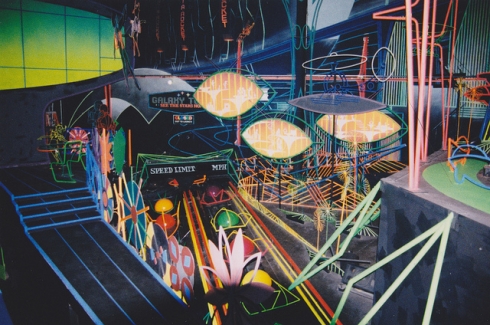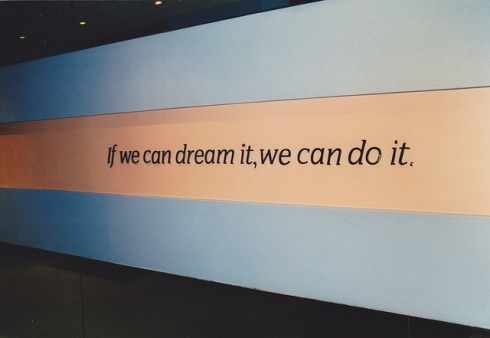2. Scenic Design
It wasn't just the ride's expansive story that captured the minds of Epcot's guests, but its futuristic and awe-inspiring design work too.
The exterior of the pavilion made Horizons look like a spaceship that had landed smack in the middle of Future World East. As guests approached it from the front, it seemed larger than life and, visually, echoed the mysterious promise of the ride's promotional tagline: “Take the trip you've always dreamed of.” Upon entering the pavilion, guests encountered what looked like a futuristic port of departure, with signs pointing toward the boarding gate for “Horizons One” – the vehicle in which guests would take their trip.
The ride system was an odd combination of Disney's classic omnimover system and a suspended tram, with guests sitting in continuously moving cars suspended from an overhead track. This unique system truly made the attraction feel like something from another time – or, more broadly, like it had the power to take you to different times and eras. And then, of course, the individual show scenes were designed with the same precision and eye for detail as all of Disney's other classic attractions.
All in all, the design of the ride conveyed a sense of vastness that connected the visual aesthetic of the ride to the overarching themes of the ride – exploration, invention, and ambition.
3. Music and Sound
The overall auditory experience of Horizons remained consistent with its hopeful story and its futuristic visual aesthetic. Disney composer George Wilkins produced a beautiful and moving score for Horizons – one that matched the airy, electronic vibe contained within the attraction itself. While most Disney composers are tasked with more straightforward stories and tones, Wilkins' duties included writing music that could thematically link across vastly different settings, including a Southwestern desert, undersea habitat, and orbiting space station. And, on top of all of that, he'd have to compose a theme song for the attraction – one which was as inspiring and hopeful as the ride itself.
He did all of that, and his song “New Horizons” served as a perfect intro and conclusion to the ride experience. His music, like some of the other great compositions in Disney history, worked perfectly in tandem with the ride, such that both the sound and the visuals were even more beautiful together than either was separately.
Add to that a wonderfully scripted narration that connects the two halves of the attraction – “looking back at tomorrow” and the trip to the future – and you wind up with an attraction so aesthetically complete that a generation of Disney fans still can't stop thinking about it.
4. Message
One popular interpretation of Horizons is as a sequel to Walt Disney's Carousel of Progress. In both attractions, we follow along with a family as they interact with the world around them, encountering different innovations and inventions that mark the passage of time. Just as Carousel of Progress takes guests on a trip back in time, Horizons takes the park goer forward, and shows them what that same family might experience decades into the future.
But just as any sequel pushes the story forward, so too does Horizons explore a deeper meaning for the concept of progress. In Horizons, progress isn't just the invention of a stove or an electric light, but rather, something larger and more universal. Horizons' progress isn't just trinkets, but social movements.
In Horizons' future, mankind has spread much further apart, now inhabiting areas previously thought uninhabitable – the desert, the ocean floor, and space. But these areas aren't just for work, either. We see children learning in an undersea class. We encounter a kid playing with his shoe in zero gravity. These people live in this areas out of intellectual curiosity more than anything else.
Similarly, while Carousel of Progress focuses on the nuclear family, Horizons expands its scope to the extended family – with our two narrators showing us how each of their children have lives and families of their own.
And so, ultimately, what separates Horizons from its fellow Epcot attractions is its message – a synthesis of all these elements: story, design and music. For in Horizons, the future is about exploring what it means to be human, and empowering yourself to do that exploration on your own terms.
“If you can dream it, then you can do it,” goes the chorus of New Horizons, seemingly drawn from the Sherman Brothers' declaration that “tomorrow is just a dream away.” And for this reason, the ride concludes by asking guests to choose their own ending. The future doesn't arrive on its own – you've got to create it for yourself.



Comments
As a kid in the 80's this was the ride that made me so excited to see what the future might hold. And that Orange Grove.
Truly the best attraction EPCOT Center ever had. Would love more than anything for it to return. Especially now with the Wonders of Life pavilion used as little more than a sales floor for special events, there is still room in Future World to resurrect this gem. "If you can dream it, then you can do it" - so many people dream of this attraction returning, c'mon Disney, you can do it!